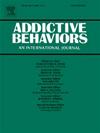ABCD 研究中的美国青少年心理和躯体症状并存轨迹对早发性药物使用的影响
IF 3.7
2区 医学
Q1 PSYCHOLOGY, CLINICAL
引用次数: 0
摘要
背景青少年使用药物(SU)的动机通常是为了缓解不良症状。为了验证自我药疗假说,我们研究了青春期早期合并心理和躯体症状轨迹与早期发病 SU 之间的关联。方法利用青少年大脑认知发展研究®的数据,我们根据合并焦虑、抑郁、疼痛、躯体和嗜睡症状轨迹对基线时未报告 SU 的青少年进行了区分。结果831名参与者在9.97 ± 0.74岁至13.57 ± 0.88岁期间的症状轨迹分为无症状(27.8%)、低度/稳定(39%)、中度/持续(25.3%)或高度/恶化(7.9%)。中度-高度症状轨迹组比无症状-低症状轨迹组的早发 SU 高 56%(12.5% 对 8.5%;OR 1.56 [95 % CI 1.33,1.79])。经协变量调整后,高度/恶化组比无症状组更有可能报告使用任何物质(adj.OR 2.13 [95 % CI 1.40, 3.25])、酒精(adj.OR 2.80 [95 % CI 1.56, 5.02])、烟草(adj.OR 2.09 [95 % CI 1.23, 3.55])和大麻(adj.OR 2.33 [95 % CI 1.36, 3.99])。纵向时滞分析显示,早期抑郁症对随后的 SU 有潜在的反馈作用,而早期 SU 对后来的抑郁症有潜在的反馈作用(p < 0.001)。由于负反馈循环可能会导致症状持续存在,对高危青少年造成持续和潜在的危害,因此有必要解决儿童晚期出现的合并症状。本文章由计算机程序翻译,如有差异,请以英文原文为准。
Effect of comorbid psychologic and somatic symptom trajectories on early onset substance use among U.S. youth in the ABCD study
Background
Adolescent substance use (SU) is often motivated by a desire to alleviate undesirable symptoms. To test the self-medication hypothesis, we examined associations between comorbid psychologic and somatic symptom trajectories across early adolescence and early onset SU.
Methods
Using Adolescent Brain Cognitive Development Study® data, we differentiated youth who reported no SU at baseline based on their comorbid anxiety, depression, pain, somatic and somnolence symptom trajectories. The outcome, early onset SU (by age 13–14 years) was derived from self-reported alcohol (≥full drink), tobacco (full regular/e-cigarette), marijuana, or other drug use over 5 years.
Results
8311 participants were classified with Asymptomatic (27.8 %), Low/stable (39 %), Moderate/persistent (25.3 %) or High/worsening trajectories (7.9 %) from age 9.97 ± 0.74 to 13.57 ± 0.88 years. Early onset SU was 56 % higher for Moderate-High compared to Asymptomatic-Low symptom trajectory groups (12.5 % vs. 8.5 %; OR 1.56 [95 % CI 1.33, 1.79]). Adjusted for covariates, the High/worsening group was more likely than the Asymptomatic group to report use of any substance (adj.OR 2.13 [95 % CI 1.40, 3.25], Alcohol (adj.OR 2.80 [95 % CI 1.56, 5.02]), Tobacco (adj.OR 2.09 [95 % CI 1.23, 3.55]), and Marijuana (adj.OR 2.33 [95 % CI 1.36, 3.99]). Longitudinal, time-lagged analyses revealed potential feedback effects of earlier depression on subsequent SU, and earlier SU on later depression (p < 0.001).
Conclusion
Higher comorbid symptom trajectories emerging in late childhood increased the likelihood of early onset SU. Since negative feedback loops may contribute to symptom persistency, ongoing and potentially harmful SU for at-risk youth, addressing comorbid symptoms that emerge during late childhood is warranted.
求助全文
通过发布文献求助,成功后即可免费获取论文全文。
去求助
来源期刊

Addictive behaviors
医学-药物滥用
CiteScore
8.40
自引率
4.50%
发文量
283
审稿时长
46 days
期刊介绍:
Addictive Behaviors is an international peer-reviewed journal publishing high quality human research on addictive behaviors and disorders since 1975. The journal accepts submissions of full-length papers and short communications on substance-related addictions such as the abuse of alcohol, drugs and nicotine, and behavioral addictions involving gambling and technology. We primarily publish behavioral and psychosocial research but our articles span the fields of psychology, sociology, psychiatry, epidemiology, social policy, medicine, pharmacology and neuroscience. While theoretical orientations are diverse, the emphasis of the journal is primarily empirical. That is, sound experimental design combined with valid, reliable assessment and evaluation procedures are a requisite for acceptance. However, innovative and empirically oriented case studies that might encourage new lines of inquiry are accepted as well. Studies that clearly contribute to current knowledge of etiology, prevention, social policy or treatment are given priority. Scholarly commentaries on topical issues, systematic reviews, and mini reviews are encouraged. We especially welcome multimedia papers that incorporate video or audio components to better display methodology or findings.
Studies can also be submitted to Addictive Behaviors? companion title, the open access journal Addictive Behaviors Reports, which has a particular interest in ''non-traditional'', innovative and empirically-oriented research such as negative/null data papers, replication studies, case reports on novel treatments, and cross-cultural research.
 求助内容:
求助内容: 应助结果提醒方式:
应助结果提醒方式:


